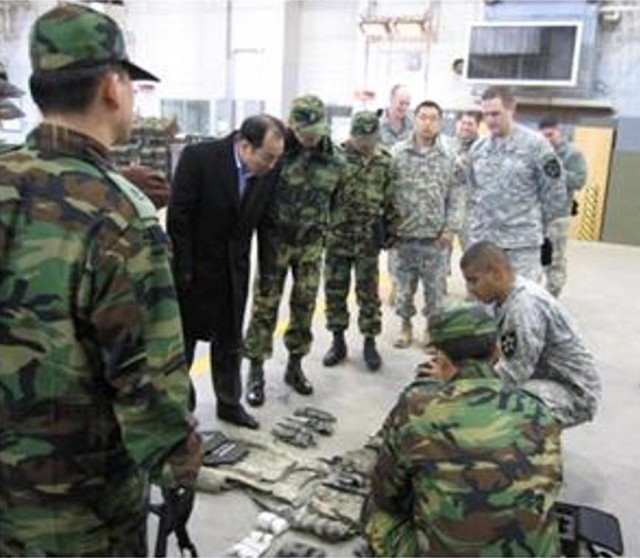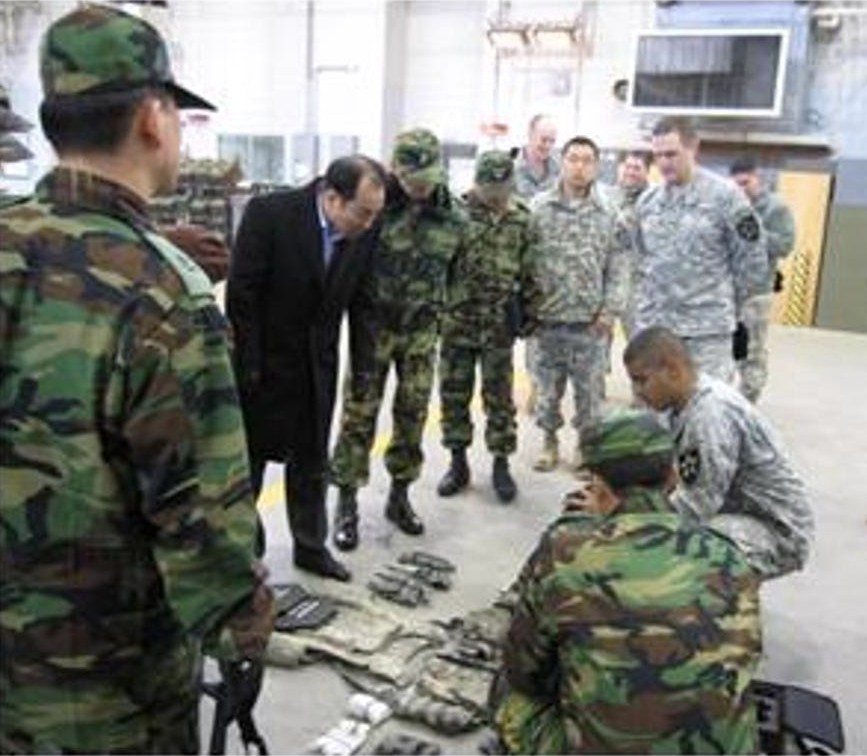Allies helped allies prepare for the rigors of operations in Afghanistan during Jan. 7 at K-16 Air Base.
Soldiers and leaders from 2nd Battalion (Assault), 2nd Aviation Regiment, 2nd Combat Aviation Brigade discussed deployment and aviation tactics, techniques and procedures with Republic of Korea Army Brig. Gen. Bae Myeong Heon, the deputy commanding general of the ROKA Aviation Operation Command, along with seven officers and four ROKA flight crew members.
A ROKA contingent is scheduled to deploy to the Bagram area in Afghanistan in support of Operation Enduring Freedom. The ROKA unit will support the international coalition serving in Afghanistan in day-to-day operations with heavy lift missions, medical evacuation support, logistics and air assault operations.
Chief among the topics during the visit were the various types of enemy threats the ROKA unit will face in Afghanistan, the equipment necessary to function in the Afghanistan operating
environment and other pre-deployment training tasks and methods.
"This is a great opportunity for my staff and maneuver commanders to tap into the experiences and lessons learned from experienced combat veterans in 2-2nd Avn.," said Bae. "We have a general idea of what to expect before arrival in Afghanistan, my unit needs more specifics on exactly what equipment is needed in-country for our deployment," he added through a translator. "These lessons learned are very constructive for the ROKA in our upcoming deployment."
The training allowed Bae to gain a wealth of knowledge from warrant officers and other officers with combat aviation experience currently serving in 2-2nd Avn.
"My aviators and support personnel need to know the enemy threat within 200 kilometers of Bagram and the radius of our operations when we arrive in-theater," Bae said. "My main concerns are the weapons systems the Taliban and other insurgent groups presently employ against coalition assets. Bottom line: I need to know what weapons the enemy has and how
to mitigate them."
The "Wildcard" commander, Lt. Col. Matthew Lewis, offered Bae practical advice and encouraged 2-2nd Avn. company commanders to provide insights from their own personal experiences in Afghanistan.
"My intent today is to allow my aviation officers and battalion staff to inform the ROKA personnel on how best to conduct continuing operations in the hostile theater that is Afghanistan," Lewis said the day of the meeting.
"Afghanistan is a dynamic battlefield (because) the weather and enemy threats are constantly changing (and) the ROKA aviators need to be prepared for these variables. U.S. lessons learned
in Afghanistan can be directly applied to units of any country deploying to support the coalition. The ROKA is an integral component in the coalition of the willing, and a valuable friend to the
United States. We will help them in any way possible."
Fitting Korean aircraft with the correct aircraft survivability equipment is a key element of a safe, successful deployment. Lewis said that "training pilots on multiple aircraft survivability
equipment gives pilots flexibility because not all helicopters are equipped the same. Age and configuration impact what systems are fitted in particular aircraft. These Korean aviators need to
have the right systems in place for the Afghanistan environment."
The Korean leaders seemed pleased with the efforts of their 2-2nd Avn. allies.
Lt. Col. Jong Jin Kim, chief of operations planning branch ROKA, said that "2-2nd Avn. is invaluable in helping the ROKA plan for deployment. Lewis and his officers helped with communication feasibility and interoperability (so that) we know specifically what we need and have to do to deploy."
Bae asked Lewis and his Soldiers about training tasks and methods prior to deployment. Chief Warrant Officer 2 Oren Englishbee offered many tips the ROKA might need to consider.
"The minimum flight altitude should be no lower than 400 feet," he said. "Staying out of fixed wing airspace is important and never fly in the middle of a valley. This makes you an easy target. My advice to the ROKA pilots is to fly along one side of the valley and don't be an easy target for the enemy."
Lewis also emphasized the importance of packing UH-60 Blackhawks properly into containers and airplanes for the long trip from Korea. Helicopter rotors should be folded properly and the aircraft should be stowed so transit does not damage the helicopters and equipment.
"2-2nd Avn. conducts frequent training on rotor blade folding and packing up UH-60s for transit," Lewis noted. "We can show the ROKA a safe, efficient way to pack."
The frequent dust and its effect upon night vision goggle flight operations was also a meeting topic. Cpt. John Sharkey, 2-2nd Avn. battlation assistant operations officer said, "The dust in
Bagram is not as bad as other places in Afghanistan, but is a concern for inexperienced pilots. ROKA pilots need to adjust to flying at night with NVGs because flying in dust at night is one of
the most difficult modes of flying. Lack of ambient light and infrastructure creates pitch dark flying conditions."
Sharkey added, "Other good predeployment training for the ROKA unit would be to practice take-offs and landing in dust." Lewis suggested the ROK unit request additional training at either
the National Training Center at Fort Irwin, Calif. or the Joint Readiness Training Center at Fort Polk, La. Prior to deployment to train in a similar environment.
The national and international military effort to provide greater rotary lift for operations in Afghanistan is coming to fruition. ROKA aviation assets deploying to Afghanistan later this year
will provide added relief to the coalition's helicopter shortage. More international participation in OEF will provide U.S. personnel and aircraft valuable assistance and provide for more
maintenance down time.
Bae thanked 2-2nd Avn. for its assistance. "The graciousness and willingness offered by the 2-2nd Avn. Command and its Soldiers is just another example of the good relationship the
U.S. Army and the ROKA share here on the peninsula," he said. "This meeting is one of the best officer professional development meetings I have been a part of."
"The ROKA and the U.S. Army have a unique relationship here in Korea," Lewis said in closing. "It is essential that we assist our friends and neighbors in every way possible, here
at K-16 and elsewhere on the peninsula."


Social Sharing